What Is Video Art? – Art in the Age of Technological Development
In the constantly evolving and ever-expanding realm of artistic expression, a captivating medium has been able to emerge, one that challenges conventional boundaries and ignites a sensory revolution – video art. So, what is video art? It is a question that propels us into a mesmerizing realm where visual narratives intertwine with technological prowess, redefining the very essence of creativity. Delving into the definition of video art unveils a world where screens become canvases, pixels pulse with emotion, and time itself becomes a malleable brushstroke. From the pioneers of the past who dared to wield cameras as their artistic implements to the contemporary video artists shaping our digital age, the history of video art is a journey of innovation and audacious imagination. Step with us into this dimension where frames are alive, colors dance with intention, and the very fabric of storytelling gets rewoven by the hands of video artists.
Contents
- 1 The History of Video Art
- 2 Characteristics and Elements of Video Art
- 3 The Different Forms of Video Art
- 4 How Video Art Differs from Other Visual Art Forms
- 5 Influential Video Artists and Their Notable Works
- 6 Video Art in Contemporary Culture
- 7 The Impact and Critique of Video Art
- 8 The Future of Video Art
- 9 Frequently Asked Questions
The History of Video Art
The history of video art is a mesmerizing journey through the intersection of technology and creativity. It was in the dynamic landscape of the 1960s and 1970s that this innovative medium took its first electrifying steps. Pioneers like Nam June Paik sparked a revolution by harnessing the power of the cathode ray tube, birthing a new artistic movement that would challenge conventions and redefine artistic expression. Through screens and signals, video art emerged as a conduit for imagination, experimentation, and social commentary.
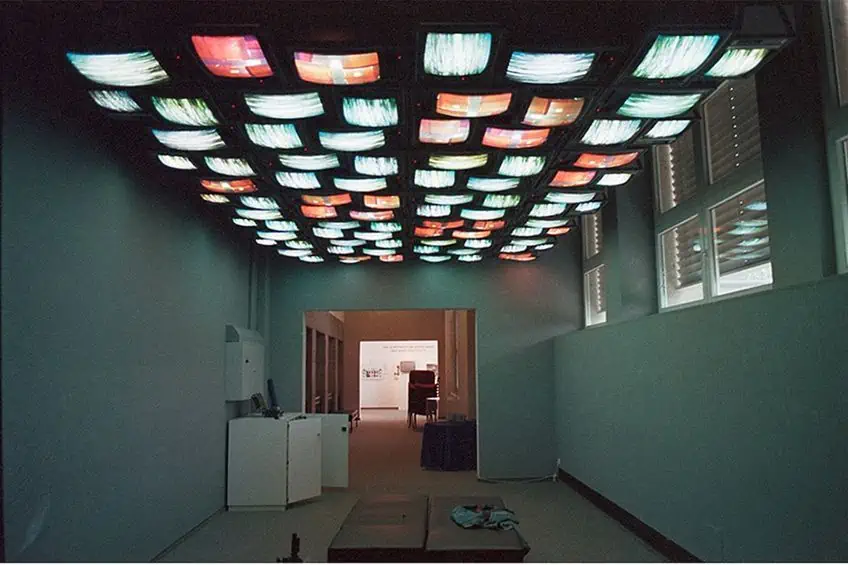
Pioneers of Video Art
The annals of art history are marked by moments of audacious innovation, and the history of video art stands as a captivating chapter in this narrative. Pioneers of this avant-garde movement dared to break free from the conventional canvas, challenging the boundaries of expression and ushering in a new era of creativity.
These visionaries were the architects of a seismic shift, where the static gave way to the dynamic, and the world would soon see the birth of an art form that would captivate for generations to come.
Nam June Paik: The Father of Video Art
In the heart of this artistic evolution, one name rises above the rest: Nam June Paik. Often revered as the “father of video art”, Paik was a maverick who harnessed technology to redefine the very essence of visual storytelling. With cathode ray tubes as his brushes and magnetic tape as his canvas, Paik painted a symphony of moving images that transcended the limits of traditional art. His innovative spirit danced across screens, rendering the rule of symmetry in ways never before imagined. Through his groundbreaking works, Paik crafted a world where video art emerged as a medium that challenged, provoked, and ultimately transformed artistic expression.

The Video Art Movement in the 1960s and 1970s
The 1960s and 1970s witnessed a seismic upheaval in the art world, as the video art movement surged to prominence. This period marked the convergence of technology and imagination, giving rise to an entirely new medium that defied definition. Video art was an exploration of the ephemeral, a canvas that breathed and pulsed with life. Artists delved into this uncharted territory, creating video art examples that ranged from experimental montages to poignant social commentary.
The boundaries of storytelling expanded, as images in motion engaged the senses in unprecedented ways.
Video artists during this era dismantled the conventional, embracing the fluidity of the medium to challenge norms and perspectives. The world became a stage where pixels danced, colors collided, and soundscapes enveloped audiences in a multisensory journey. The video art movement dared to question the fundamental nature of art itself, prompting viewers to reconsider their perceptions and assumptions
The history of video art stands as an epoch of transformation and audacity. Pioneers like Nam June Paik and the artists of the 1960s and 1970s etched their mark on history, revolutionizing the way we engage with visual expression. Video art transcended the constraints of the traditional canvas, offering a dynamic palette that captured movement, light, and sound. The pioneers’ unwavering curiosity and creative exploration opened a door to a world where the definition of art expanded, inviting us to reconsider the very essence of human expression.

Characteristics and Elements of Video Art
Video art is an intriguing realm where technology transforms into a canvas, forging immersive experiences that blur the line between viewer and creation. It thrives on the fusion of visuals and innovation, inviting audiences to step into an interactive and immersive world. Here, technology is a paintbrush, sound is a symphony, and the viewer is an active participant.
This multidimensional form of expression delves into the soul of storytelling, weaving narratives not just through visual but also through sound and music, creating a mesmerizing tapestry that challenges boundaries and reshapes our perception of art itself.
Exploring the Use of Technology
In the captivating realm of artistic innovation, video art emerges as a medium that transcends the boundaries of traditional expression. Video art is a canvas that breathes, a dynamic fusion of moving images and technology that challenges perceptions and invites audiences to explore new dimensions of creativity. At its core, video art harnesses the power of technology to redefine the artistic landscape. It paints with pixels and dances with electrons, blurring the lines between reality and imagination.

Interactivity and Immersion in Video Art
At the heart of video art lies an invitation to step into the frame and become part of the narrative. Interactivity and immersion are the secret ingredients that set video art apart. The static gallery space transforms into an interactive playground, where viewers navigate through evolving landscapes of images and emotions. Video art becomes a dialogue, a conversation between the creator and the audience, transcending the traditional role of the observer.
This immersive experience draws us into the narrative, inviting us to explore the depths of the artist’s vision.
The Role of Sound and Music in Video Art
Sound and music weave the threads that breathe life into the moving images of video art. They are the symphonic companions to the visual spectacle, shaping emotions and guiding the narrative. The carefully curated soundscape becomes a conductor of emotions, enhancing the visual elements with layers of auditory texture. The rhythm of the sound echoes the heartbeat of the imagery, creating a multisensory experience that resonates on a profound level. Sound and music elevate video art to a realm where emotions take center stage, intertwining with the visuals to craft a symphony of the senses.

In the tapestry of video art’s characteristics and elements, technology, interactivity, and sound converge to create a new language of expression. It is an art form that defies boundaries, ignites curiosity, and challenges preconceived notions. Video art transcends the static, offering a dynamic canvas where pixels pulse with life and images evolve in a dance of light and shadows. Through interactivity, viewers become participants in the narrative, shaping their own journey through the artists of the world. And as sound and music intertwine with visuals, emotions are amplified, and the story unfolds as a multisensory symphony.
Video art examples are an exploration of technology’s creative potential, an immersive that engages and challenges, and a collaboration between visual and auditory elements. It invites us to step beyond the frame and embrace a world where pixels, movement, and emotion fuse into an innovative tapestry of expression.
Just as each brushstroke carries meaning in a painting, every pixel and soundwave in video art contributes to a new visual lexicon that speaks to the ever-evolving nature of artistic creation.
The Different Forms of Video Art
Video art, a kaleidoscope of creativity, manifests itself in various captivating forms that push the boundaries of visual expression. In the realm of single-channel video art, the screen is a window to imagination, presenting narratives and emotions in a linear fashion. Multi-channel video art, on the other hand, orchestrates a symphony of screens, enveloping viewers in a sensory journey. Then there are video sculptures, where technology and art converge to create immersive, tangible installations. And in the realm of video performance art, artists transcend the confines of screens, crafting dynamic, live experiences that challenge norms.

Single-Channel Video Art
The form known as single-channel video art stands as a cornerstone in this innovative realm. Like a visual poem, it unfolds on a single screen, captivating viewers with its storytelling prowess. Whether exploring societal commentary, personal introspection, or the surreal, single-channel video art offers an intimate window into the artist’s perspective.
It is a conversation that unfolds between the creator and the audience, igniting thoughts and emotions that transcend the boundaries of time and space.
Multi-Channel Video Installations
Stepping beyond the confines of a single screen, multi-channel video art invites viewers into a multisensory symphony of imagery. This form is a tapestry woven from multiple screens, where pixels converge to create a harmonious visual spectacle. Just as an orchestra is composed of diverse instruments, each channel in multi-channel video art contributes a unique voice to the narrative. The result is an immersive experience that envelops the audience, inviting them to explore a multidimensional reality.
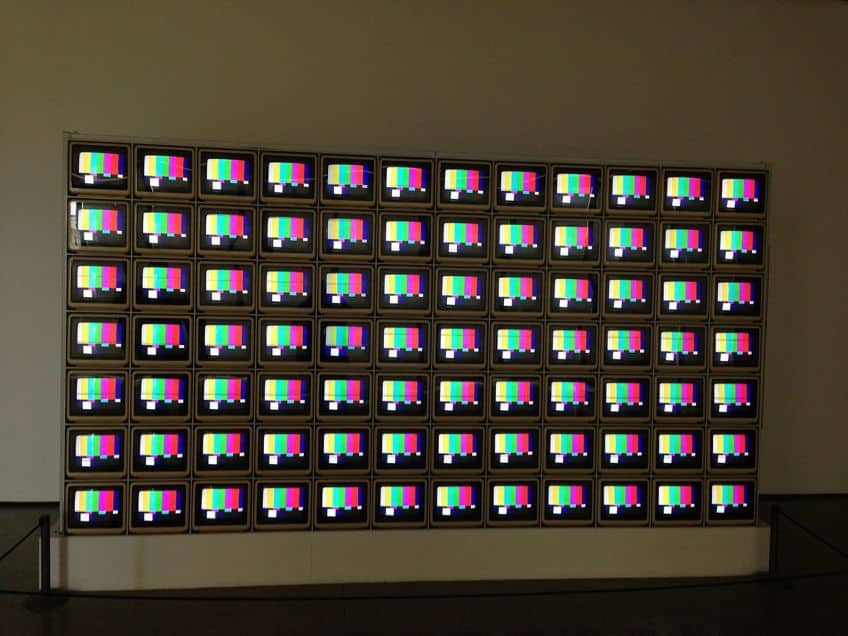
Video Sculptures and Video Performance Art
Video art is not confined to traditional screens; it ventures into the realm of the tangible through video sculptures. These three-dimensional creations marry the visual with the physical, giving form to concepts that transcend traditional dimensions. Video sculptures blur the line between object and image, adding a tactile layer to the visual narrative. They redefine the space they inhabit, inviting viewers to navigate around and through their immersive reality.
Video performance art, on the other hand, transforms the artist into a living canvas.
It is a captivating dance where movement and technology converge to craft a narrative that is both ephemeral and indelible. The human form becomes a vessel for pixels and light, as the artist’s movements shape and reshape the visual composition. Video performance art captures fleeting moments that resonate in the viewer’s memory, bridging the gap between artistic expression and human experience.
In the mosaic of different forms of video art, each shape and structure adds a layer of complexity and depth to the canvas of creativity. From the intimate embrace of single-layer video art to the immersive symphony of multi-channel installations, and from the tangible allure of video sculptures to the ephemeral dance of video performance art, video art defies categorization. It is an evolving language that adapts to the artist’s vision and invites the audience to step beyond the ordinary and into a realm where pixels become poetry, movement becomes melody, and the boundaries of artistic expression are redefined.

How Video Art Differs from Other Visual Art Forms
As a mesmerizing genre in the realm of visual expression, video art stands as a captivating departure from traditional visual art and mainstream cinema. While traditional art captures moments in stillness and painting, film unfolds narratives in linear motion, video art emerges as a dynamic fusion of both. It transcends the static canvas, evoking emotions through time and movement.
Unlike the structured storytelling of cinema, video art thrives in ambiguity and abstraction, challenging viewers to interpret and engage actively.
Video Art vs. Film: Defining the Distinctions
When looking towards the vast landscape of artistic expression, it becomes clear that video art has been able to emerge as a dynamic medium that dances on the edge of innovation, distinguishing itself from the realms of film and traditional visual art. While film tells stories through moving images, video art creates a sensory experience that transcends the linear narrative.
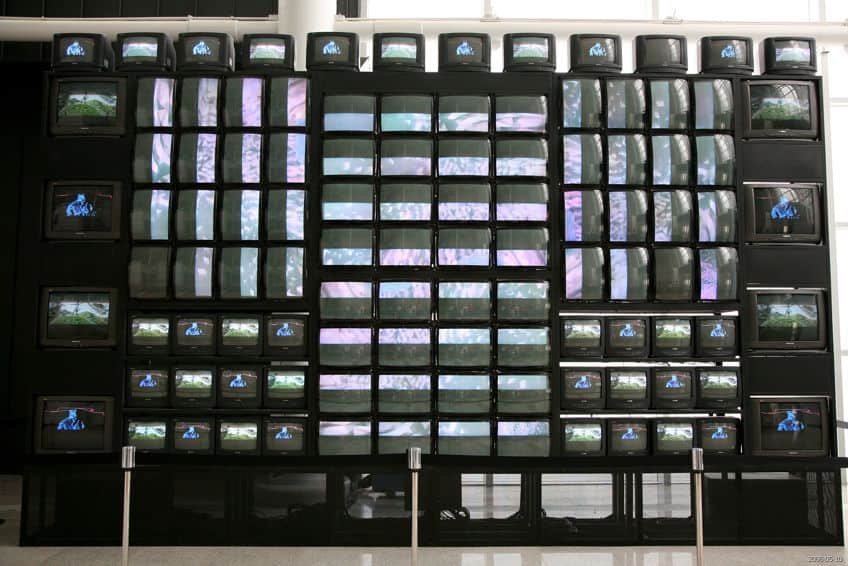
Video art is not constrained by conventional storytelling; it is a canvas where pixels pulse with emotions, and concepts invite viewers to explore new dimensions of perception. Unlike film’s structured plotlines, video art often experiments with abstraction, blurring the lines between reality and imagination. Video art is not bound by cinematic conventions; it is an exploration of the very essence of visual expression.
Video Art vs. Traditional Visual Art: Contrasts and Similarities
As the definition of art continues to evolve, video art emerges as a distinct form that challenges the parameters of traditional visual art. While paintings and sculptures captivate with static beauty, video art pulses with life, harnessing the power of technology to paint with moving images. Traditional art, however, is an encounter with a single moment frozen in time, whereas video art extends time, capturing the ebb and flow of emotions and ideas. The canvas of video art is not confined by physical boundaries; it is a realm where images merge, transform, and evolve. The interplay of light, color, and movement creates a symphony of the senses that traditional art just simply cannot replicate.
Video at is not confined by the limitations of materials; it is a medium that fuses visual storytelling with the fluidity of technology
In the mosaic of artistic expression, video art stands as a testament to the fusion of technology and imagination. It distinguishes itself from film through its experimental narrative and departure from conventional storytelling, offering a canvas where emotion and concept come alive. In comparison to traditional visual art, video art is a dynamic symphony of moving images that defies the constraints of static beauty. As boundaries between artistic mediums blur, video art emerges as a distinct language, speaking to the ever-evolving nature of human creativity. It is not just a genre; it is an experience that extends beyond the frame, inviting viewers to explore the limitless possibilities of visual experience.
Influential Video Artists and Their Notable Works
In the realm of video art, luminaries like Bill Viola, Pipilotti Rist, and Ragnar Kjartansson have carved indelible marks on the canvas of creativity. Their visionary works transcend the boundaries of conventional art, pushing the limits of what video can achieve. Bill Viola’s immersive narratives delve into the depths of human emotion, while Pipilotti’s kaleidoscopic visuals challenge perceptions and reality. Ragnar’s arresting performances evoke a sense of timeless introspection. Together, these influential video artists stand as pioneers, shaping the very essence of contemporary and visual storytelling.

Bill Viola: Exploring Human Emotions Through Video Art
Within the realm of video art, certain luminaries have emerged, shaping the landscape with their unique visions and innovative storytelling. Bill Viola stands as a pioneering figure, who delves into the depths of human emotions through the lens of video art. His works are visual symphonies that resonate with the human experience, inviting viewers to embark on journeys of introspection. Viola’s pieces are immersive explorations of love, birth, death, and spirituality, capturing moments that transcend the limitations of words.
Through his masterful manipulation of moving images, Viola crafts narratives that tap into the reservoir of human emotion, leaving an indelible mark on the world of video art.
Pipilotti Rist: Playfulness and Feminism in Video Art
In the medium of video art, Pipilotti Rist’s name shines as a beacon of playfulness and feminism. Her works are a kaleidoscope of colors and sensations, challenging norms and inviting viewers to see the world through a different lens. Rist’s video art is a celebration of the sensory experience, where images dance with music and movement.
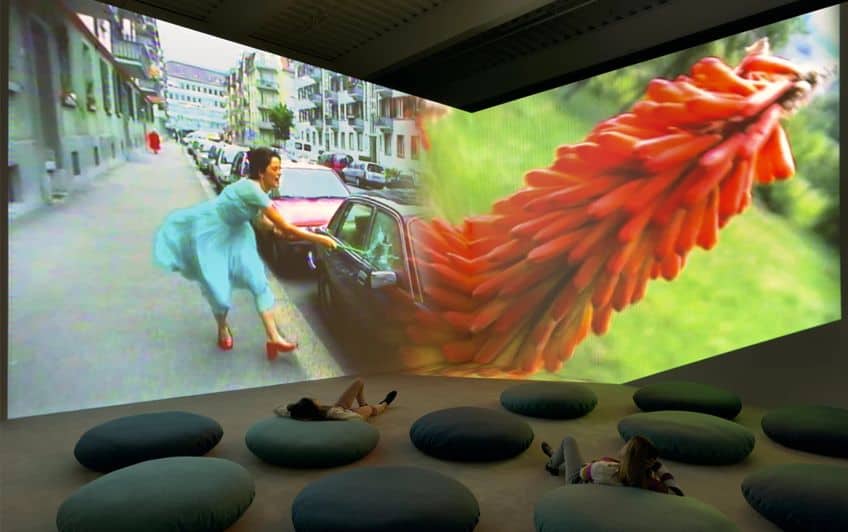
Themes of gender, identity, and the female body intertwine with whimsical landscapes, creating a narrative that is both thought-provoking and liberating. Rist’s videos are more than visual compositions; they are invitations to embrace the unconventional, to question societal constructs, and to revel in the beauty of artistic rebellion.
Ragnar Kjartansson: Narrative and Duration in Video Art
Amidst the tapestry of influential video artists, Ragnar Kjartansson stands as a storyteller who weaves narratives through the lens of duration. His works are cinematic canvases that unfold in real-time, inviting viewers to be both witnesses and participants in the narrative. Kjartansson’s video art is an exploration of time’s fluidity, a meditation on the ephemeral nature of existence. His performances, often characterized by repetition and prolonged duration, create an immersive experience where viewers are compelled to reflect on the passage of time and the layers of meaning that accumulate within it.
Kjartansson’s videos challenge traditional storytelling, blurring the lines between art, performance, and the passage of time itself.
Luminaries such as Bill Viola, Pipilotti Rist, and Ragnar Kjartansson have each carved their names into the annals of creative innovation. Their works transcend mere visuals, touching the realms of human emotions, playfulness, feminism, narrative, and the passage of time. Through their visionary expressions, these influential artists redefine the boundaries of storytelling, refining and expanding the definition of video art, provoking thought, evoking sensation, and inspiring generations to embrace the limitless potential of video art as a medium of profound artistic exploration.
Video Art in Contemporary Culture
Video art is a form of expression that transcends traditional boundaries, captivating audiences with its visual narratives and immersive experiences. In galleries, video art invites introspection, challenging perceptions and sparking dialogue. In public spaces, it becomes a shared spectacle, connecting communities through its bold statements. And in the digital sphere, it finds a boundless canvas, reaching global audiences instantaneously.
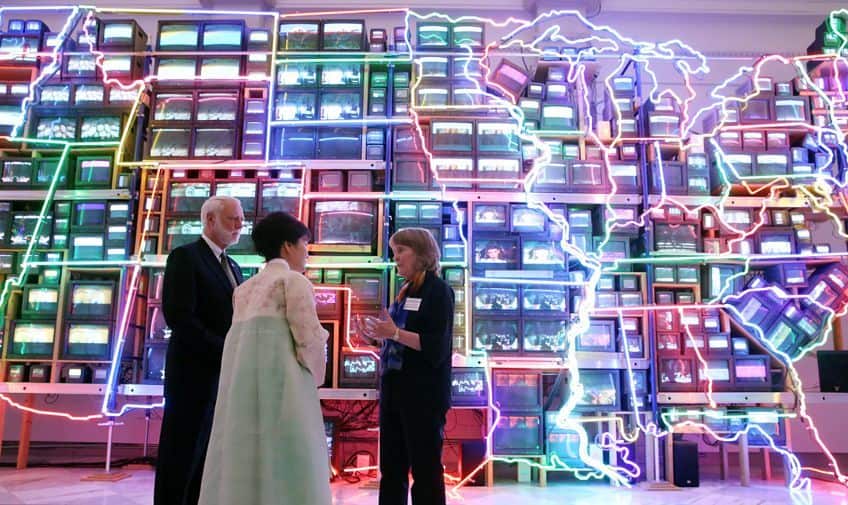
Video Art in Galleries and Museums
Within the landscape of video art, galleries and museums stand as hallowed grounds where the fusion of moving images and technology takes center stage. Video art transforms these spaces into immersive realms where narratives pulse with life, engaging viewers in a multisensory dance of light and emotion.
As visitors step into these hushed havens, they encounter video art examples that transcend the traditional canvas, offering glimpses into worlds where pixels intertwine to craft narratives that evoke introspection, provoke thought, and resonate with the complexities of the human experience.
Video Art in Public Spaces and Installations
The streets and squares, once dominated by static monuments, have now become stages for a new form of artistic dialogue: video art installations. In contemporary culture, public spaces are transformed into arenas where moving images illuminate the urban canvas. These installations challenge the confines of conventional art spaces, inviting passersby to engage with narratives that unfold against the backdrop of the city’s pulse. Video art installations redefine the concept of “public art”, breathing life into architecture and urban landscapes. They become temporal intersections of technology and humanity, reminding us that art is not confined to walls but thrives within the rhythm of daily life.
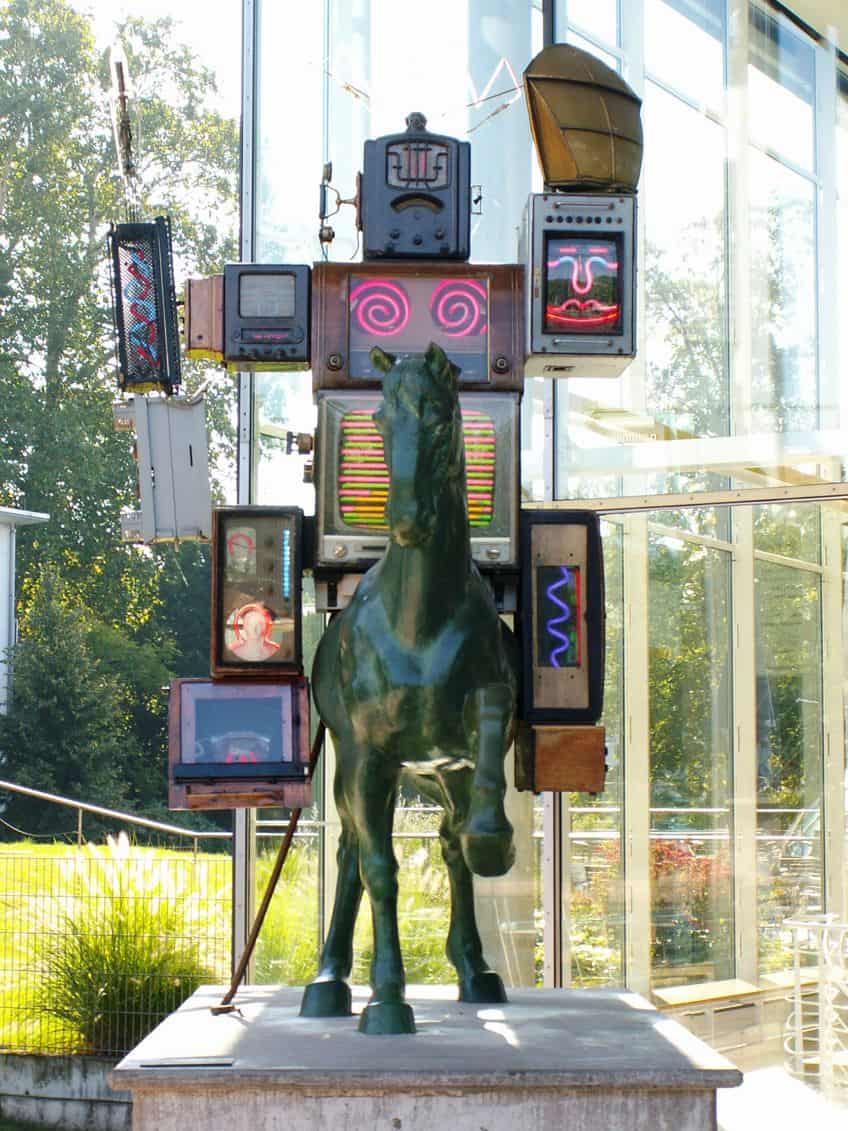
Video Art in the Digital Age: Online Platforms and Social Media
As the digital age sweeps us into its embrace, video art finds new avenues for expression through online platforms and social media. The screens that have become ubiquitous in our lives transform into portals of artistic exploration. Video art examples, once confined to physical spaces, now transcend the limits of geography, reaching audiences across the globe with a single click. Online platforms become galleries without walls, allowing creators to share their narratives with a diverse and engaged audience.
Social media amplifies the impact of video art, fostering conversations, connections, and communities that extend far beyond traditional artistic circles, leaving more and more people wondering about and providing their own answers to the question, “What is video art?” Video art, in the digital age, is not limited by physical constraints; it travels freely, transcending boundaries and reminding us that art’s potential is as boundless as the human imagination.
It challenges perceptions, engages the senses, and provokes thought, transcending traditional definitions of art. From the hallowed halls of museums to the bustling streets and the screens we carry in our pockets, video art examples are a testament to the ever-evolving nature of human expression. As technology and creativity merge, video art becomes a dynamic language that speaks to the complexities of our time, inviting us to journey beyond the confines of the familiar and embrace the limitless possibilities that await within the realm of moving images.
The Impact and Critique of Video Art
The impact of video art on society and politics is a riveting narrative of influence and interpretation. It stands at the intersection of art and activism, a powerful medium for social commentary, protest, and reflection. Yet, amidst its profound effects, video art is not without its criticisms and misconceptions. Some argue it veers into obscurity, while others question its accessibility. But within this discourse lies the essence of its power – to provoke thought, spark dialogue, and challenge the status quo.

The Role of Video Art in Society and Politics
Within the dynamic currents of contemporary culture, video art emerges as a potent catalyst that not only reflects society but also shapes the discourse surrounding it. In this realm of moving images and visual storytelling, video art becomes a canvas for artists to engage with societal and political narratives. As an expressive medium, it delves into the heart of issues, stirring conversations and sparking reflection. Video art has the power to ignite change, to challenge the status quo, and to amplify voices that might otherwise be silenced.
It becomes a lens through which society examines its values, aspirations, and contradictions, prompting viewers to question, contemplate, and engage with the complexities of our world.
Addressing the Criticisms and Misconceptions Surrounding Video Art
Yet, within the embrace of its transformative potential, video art is not immune to critique and misconceptions. Critics often question its place in the realm of traditional visual art, raising concerns about its authenticity and impact. Some view video art as an abstract realm, challenging to understand and make distinctions from everyday experience. Misconceptions suggest that it is an exclusive form of expression, limited to the technologically adept, and detached from the broader human experience.

In response, advocates of video art emphasize its ability to transcend boundaries, both artistic and societal. It challenges conventions precisely by defying traditional norms, inviting viewers to explore new dimensions of expression. Video art does not shy away from its interactive and immersive nature; it harnesses technology to create narratives that resonate deeply with the contemporary human experience. Addressing the misconceptions, proponents underline that video art is not detached but deeply rooted in the tapestry of life.
The impact of video art is far-reaching and multi-faceted, embedding itself within the fabric of society and culture. It stands as a powerful tool for artists to engage with the pressing issues of our times, becoming a mirror that reflects and a megaphone that amplifies. While criticism and misconceptions are inevitable, they illuminate the need for a broader understanding of video art’s potential and significance. As this art form continues to evolve and push boundaries, it invites us to see beyond the surface and engage with the intricate narratives it presents.
Video art, with its unique ability to blend innovation, introspection, and societal dialogue, will undoubtedly continue to leave an indelible mark on the landscape of contemporary culture.
The Future of Video Art
The future of video art is a boundless horizon, where innovating and experimentation intertwine to reshape our perceptions of visual storytelling. As technology continues to advance, video art evolves in captivating ways. Emerging trends embrace augmented and virtual realities, pushing boundaries in immersive experiences. Experimental approaches blur the lines between the digital and physical realms, challenging conventions and sparking new dialogues. With an ever-expanding toolkit of techniques, from artificial intelligence to interactive installation, the future of video art promises to be a thrilling journey into uncharted territories of creation.

Emerging Trends and Experimental Approaches
As the canvas of artistic expression continues to evolve, the future of video art emerges as a realm of limitless possibilities and uncharted territories. Within this landscape, emerging trends and experimental approaches redefine the boundaries of what is possible. Video art transcends its origins, embracing technology and innovation in novel ways. Augmented reality (AR) and virtual reality (VR) become extensions of the canvas, inviting viewers to step into immersive narratives that blur the lines between the real and the imagined. Interactive installations push the envelope, transforming spectators into participants, engaging them in dialogues that unfold beyond the frame.
Projection mapping and multimedia integration challenges the traditional exhibition spaces, turning architecture itself into a canvas for storytelling.
Video Art as a Reflection of Cultural Shifts and Global Issues
The future of video art is intrinsically tied to the tapestry of cultural shifts and global issues that shape our world. As a mirror of society, it holds the potential to capture the nuances of change and provoke conversations about the issues that define our times. Video artists become cultural commentators, addressing themes of identity, environmental concerns, social justice, and technological advancements. In an era of connectivity, video art becomes a bridge that spans languages and borders, connecting audiences across the globe in a shared experience. It resonates with the complexities of our interconnected world, capturing the pulse of humanity and reflecting the kaleidoscope of perspectives.

The trajectory of video art is one of evolution and expansion, marked by innovative trends and a deeper resonance with the world’s shifting dynamics. Artists experiment with mediums, technologies, and approaches that challenge preconceived notions and create new languages of expression. The digital age, with its rapid pace and interconnectedness, provides fertile ground for video art to flourish. As the boundaries of technology and art continue to merge, the canvas of video art expands to embrace the digital realms that define our lives.
In the future, when people ask themselves and others, “What is video art?”, it will be seen as not only a visual spectacle but as a catalyst for dialogue, empathy, and understanding. It will continue to be a reflection of our collective consciousness, capturing both the triumphs and challenges of our era. As artists push the envelope and audiences engage with narratives that transcend traditional boundaries, video art will remain a testament to the resilience of creativity, offering a window into the human experience that is as vast and diverse as the world it seeks to illuminate.
Frequently Asked Questions
What Is Video Art, and How Is It Different from Other Visual Art Forms?
Video art is a creative medium that involves the use of moving images, often accompanied by sound, to convey artistic concepts and narratives. Unlike traditional visual art forms like painting or sculpture, video art uses technology to create dynamic and time-based compositions. It allows artists to explore movement, time, and interactivity, making it a distinct form of expression that engages viewers through the passage of time and the evolution of imagery.
Who Are Some of the Most Influential Artists of All Time?
Several video artists have left an indelible mark on the art world. Nam June Paik, often considered to be the father of video art, pioneered the medium’s early development. Bill Viola’s emotionally resonant works have explored human experiences, while Pipilott Rist’s vibrant and feminist-inspired creations challenge societal norms. Contemporary artists like Ragnar Kjartansson continue to push boundaries, incorporating time and duration as essential elements in their narratives.
How Has Technology Influenced the Development of Video Art?
Technology has been a driving force behind the evolution of video art. The availability of video recording equipment, editing software, and digital platforms has democratized the creation and distribution of video art. Technological advancements have enabled artists to experiment with different visual effects, manipulate time and space, and create immersive experiences. From analog to digital formats, technology has expanded the possibilities for artists to convey their ideas and emotions through moving images.
Liam Davis is an experienced art historian with demonstrated experience in the industry. After graduating from the Academy of Art History with a bachelor’s degree, Liam worked for many years as a copywriter for various art magazines and online art galleries. He also worked as an art curator for an art gallery in Illinois before working now as editor-in-chief for artfilemagazine.com. Liam’s passion is, aside from sculptures from the Roman and Greek periods, cave paintings, and neolithic art.
Learn more about Liam Davis and about us.
Cite this Article
Liam, Davis, “What Is Video Art? – Art in the Age of Technological Development.” artfilemagazine – Your Online Art Source. September 19, 2023. URL: https://artfilemagazine.com/what-is-video-art/
Davis, L. (2023, 19 September). What Is Video Art? – Art in the Age of Technological Development. artfilemagazine – Your Online Art Source. https://artfilemagazine.com/what-is-video-art/
Davis, Liam. “What Is Video Art? – Art in the Age of Technological Development.” artfilemagazine – Your Online Art Source, September 19, 2023. https://artfilemagazine.com/what-is-video-art/.



